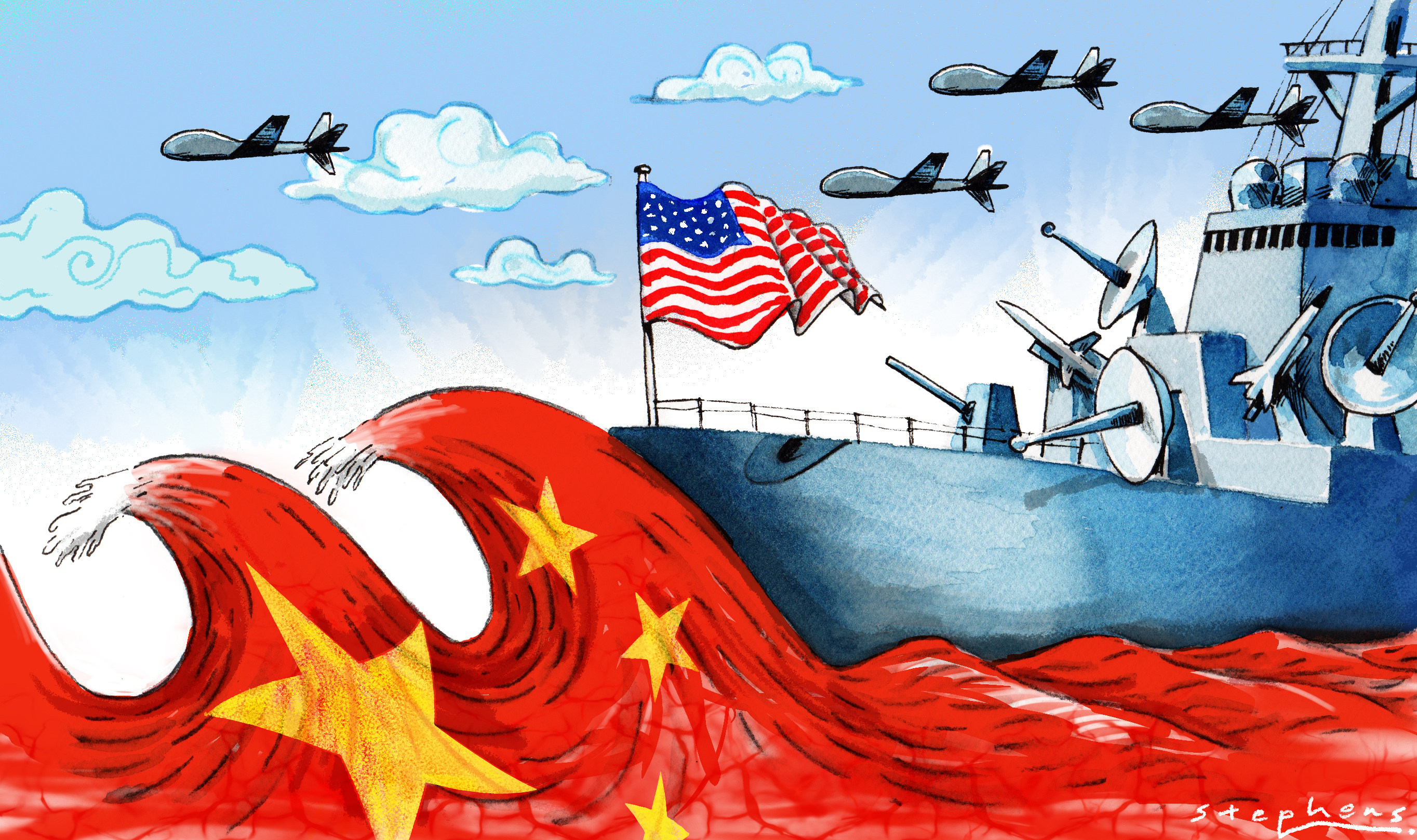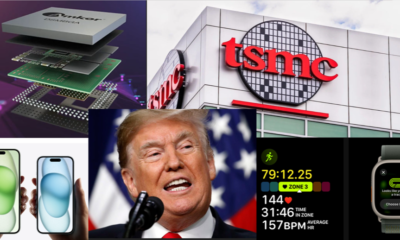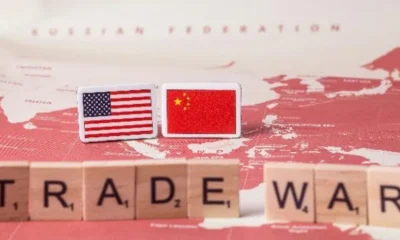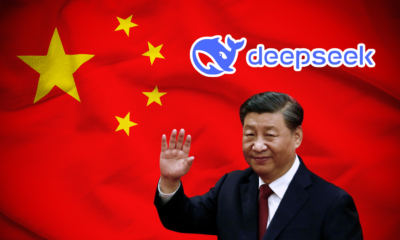Trends
Taiwan Gears Up For A Major Military Deal With The US—Trump’s New Taiwan Stand Rattles China! Is Another Ukraine In The Making?
Published
8 months agoon

Taiwan is reportedly in the final stages of negotiating a multi-billion-dollar arms deal with the United States, a move likely to intensify tensions with China. According to sources familiar with the discussions, the self-governing island is looking to acquire advanced weaponry, including coastal defense cruise missiles and High Mobility Artillery Rocket Systems (HIMARS), with the price tag expected to be between $7 billion and $10 billion.
A Strategic Show of Strength
One source noted that Taiwan’s intent behind this massive military procurement is not just about strengthening its defense capabilities but also about reaffirming its commitment to self-defense to Washington. The deal, if finalized, will mark another chapter in Taiwan’s ongoing effort to deter any military aggression from China, which has never ruled out the use of force to bring the island under its control.
Taiwan’s defense ministry refrained from commenting on the specifics of the deal but emphasized that the nation remains focused on enhancing its defensive capabilities. “Any weaponry and equipment that can help in achieving our goal of strengthening military preparedness are listed as procurement priorities,” a defense ministry spokesperson said.
Trump’s Taiwan Gamble
U.S. President Donald Trump, now making a return to the political scene, has adopted an intriguing stance on Taiwan. While he has openly criticized the island for allegedly “stealing” American semiconductor business and even threatened tariffs on chip imports, his administration has simultaneously taken a strong diplomatic and military stance in favor of Taiwan.
On February 7, Trump and Japanese Prime Minister Shigeru Ishiba released a joint statement opposing any attempts to alter the status quo in the Taiwan Strait through force or coercion. In a more symbolic yet significant move, the U.S. State Department also removed language from its website that previously stated it does not support Taiwan’s independence—a decision that Taiwan’s government welcomed but which drew sharp criticism from Beijing.
Taiwanese officials remain cautiously optimistic about Trump’s foreign policy, seeing promising signals in terms of arms sales and strategic support, despite the concerns over tariffs on semiconductors. Historically, Trump’s presidency from 2017 to 2021 saw unprecedented arms deals with Taiwan, including multi-billion-dollar transactions for F-16 fighter jets. His successor, Joe Biden, continued this trend, though on a comparatively smaller scale.
China Sees Red
China is fuming—the Chinese government has called on Washington to “rectify its mistakes” after an update on the U.S. Department of State’s website tweaked its language on Taiwan.
The Trump administration quietly removed a line that stated the U.S. does not support Taiwan’s independence. And just like that, Beijing went into full meltdown mode. Taiwan, the self-ruled island that China considers a breakaway province, remains a sore spot for the Chinese Communist Party (CCP), which has repeatedly vowed to bring it back under its control—even if that means by force.
Trump’s tough-on-China stance has always been clear, but this latest move has sparked speculation. Some analysts believe this is yet another signal that the U.S. is shifting its focus from Europe to the Indo-Pacific, setting the stage for an even bigger confrontation with China.
Taiwan isn’t the only topic that gets China all worked up. Tibet and Tiananmen Square are two other red-button issues that Beijing refuses to debate. China has been in control of Tibet since the 1950s and has spent decades systematically erasing its native culture. And let’s not forget the brutal crackdown on pro-democracy activists in Tiananmen Square in 1989—a massacre that China still pretends never happened.
Why Is China Angry?
Beijing is particularly irritated because, aside from the missing disclaimer about Taiwan’s independence, the updated U.S. factsheet now emphasizes military and tech collaboration between the U.S. and Taiwan. This includes semiconductor cooperation—a sensitive topic given China’s ongoing battle for dominance in the global chip industry.
Another notable change? Previously, the U.S. stated it supported Taiwan’s membership in international organizations “where statehood is not a requirement.” Now, the wording simply says the U.S. supports Taiwan’s participation “where applicable.” Subtle but significant.
Beijing’s Meltdown
Taiwanese officials, on the other hand, welcomed the update, calling it a reaffirmation of U.S.-Taiwan ties. Predictably, China wasn’t pleased. The Chinese Foreign Ministry slammed the U.S. for sending “a seriously wrong message to Taiwan independence separatist forces” and accused Washington of using Taiwan to undermine China.
Chinese Foreign Ministry Spokesperson Guo Jiakun said, “This is yet another example of the United States’ stubborn adherence to the erroneous policy of ‘using Taiwan to suppress China.’ We urge the United States to immediately rectify its mistakes.”

Has The US Taiwan Policy Changed?
Short answer: No, Trump hasn’t changed the US stance on Taiwan.
The United States is still committed to the “One China” policy, so its position on Taiwan remains the same.
Back in January, Secretary of State Marco Rubio said the US doesn’t support Taiwan’s independence. Recently, the Department of State updated its website to emphasize that the US opposes any unilateral changes to the status quo from either side. They also clarified that any cross-Strait differences should be resolved peacefully, free from coercion, and in a way that is acceptable to the people on both sides of the Taiwan Strait.
The China-Taiwan dispute dates back to the Chinese Civil War (1945-49), where the Communists (CPC) won and set up the People’s Republic of China (PRC), while the Nationalists (Kuomintang) fled to Taiwan and established the Republic of China (ROC). Even though Taiwan operates as an independent state in practice, only 12 countries officially recognize it, with most countries recognizing the PRC as the legitimate China.
Despite this, many countries maintain strong informal ties with Taiwan, and the US has a solid economic, defense, and intelligence relationship with the island. The US is officially committed to defending Taiwan if China tries to attack.
Former President Joe Biden was a vocal supporter of Taiwan, often saying he was open to sending US military help in case of a Chinese invasion. Under Biden, the US maintained a policy of “strategic ambiguity,” meaning the US would defend Taiwan, but the specifics of that defense were kept unclear.
Biden’s statements were often nuanced, even though the media sometimes missed that. In January 2024, Biden reiterated the US commitment to Taiwan’s defense, but he did not suggest a NATO-like commitment. He framed Taiwan’s situation in the context of broader China-Russia relations, pointing out that China might be encouraged to act on Taiwan if the international community doesn’t stand firm.
Biden also reaffirmed the US commitment to the “One China” policy, stating that while the US supports it, it doesn’t mean China can use force to take Taiwan. He made it clear that the US stands with Japan and other nations to prevent any such move. When asked if he would send troops to defend Taiwan, Biden confirmed, “yes.”
From this, it’s clear that while Biden reaffirmed the US policy, he still relied on strategic ambiguity to handle Taiwan.
As for Trump, it’s unlikely that he will emerge as a strong supporter of Taiwan. He has criticized Taiwan for taking away jobs and damaging the US semiconductor industry, even threatening tariffs. To avoid these, Taiwan is reportedly planning to boost investments in the United States.
Another Ukraine in the Making?
At the Munich Security Conference, Europeans were buzzing about betrayal and “appeasement.” With Trump’s possible pullback from supporting Ukraine, many feared the U.S. might be walking away from its role as Europe’s security protector. But while Europe was on edge, things were pretty calm over in the Pacific, where U.S. generals and defense officials at the Honolulu Defence Forum were talking about ramping up support for Asian allies.
One South Korean attendee even suggested that cutting a deal with Russia might free up the U.S. to focus on China.
The quiet from Asia can partly be explained by governments keeping their heads down. They might not care much about Europe’s problems, or they’re hoping to keep Trump happy and continue relying on him for security in Asia. The countries most at risk from China’s military ambitions—like Taiwan—are especially worried that a Russian victory would only encourage China.
Take Taiwan, for instance. There’s been a long-standing argument that preventing Russia from winning in Ukraine is key to discouraging China from invading Taiwan. The “Ukraine today, Taiwan tomorrow” idea is becoming even scarier.
One Taiwanese newspaper warned that if Taiwan keeps clinging to America, it might become an “abandoned chess piece” in the broader geopolitical game. In Japan, the Nikkei editorialized, “Don’t let America decide Ukraine’s fate,” criticizing Trump for undermining trust in the U.S.
India’s approach is a little different. It’s been pursuing a “multi-aligned” foreign policy, strengthening ties with America while keeping close to Russia and even making strides with China. With the world order looking shaky, India might see an unstable settlement in Ukraine as an opportunity—maybe easier access to Russian oil or more influence in a fragmented world.
Meanwhile, Southeast Asia seems to be drifting towards China, with many countries indifferent to America’s security role. Singapore’s defense minister said America was shifting from being a force for “moral legitimacy” to a “landlord seeking rent.”
The mood at the Honolulu conference was different, though, and for a much bigger reason. While many Americans see Russia as a problem Europe should handle, China is a much more serious threat that requires allies to contain. Admiral Samuel Paparo, head of U.S. Indo-Pacific Command, warned that China’s increasing military activity around Taiwan isn’t just for show—it’s preparing for an invasion. And, on top of that, the U.S. military is running low on critical resources, making things even more difficult. China’s growing partnership with Russia and North Korea only complicates matters further.
So, how should the U.S. confront this massive threat? By investing in new technologies like AI, speeding up weapons production, and—most importantly—working more closely with allies. The geography of the region, surrounded by islands from Japan to Australia, is key for countering Chinese power and providing a solid base for U.S. forces.
At the same time, Pete Hegseth, the U.S. defense secretary, told Europe that they’d have to take more responsibility for their own defense. The U.S. is giving top priority to confronting China, which it sees as a real threat to its core national interests in the Indo-Pacific. And as Trump’s administration often says, “Uncle Sam is not here to be Uncle Sucker.”

To that end, NATO allies have been trying to show that they can help maintain the balance of power in the Pacific. A Canadian warship sailed through the Taiwan Strait, provoking China’s anger. France, Italy, and the UK have also sent military assets to the region to team up with the U.S. Navy. But Trump seems to dismiss these gestures, with Hegseth privately telling European allies that they should focus on their own region.
At the Honolulu conference, China hawks were divided on how to deal with Trump’s shift in focus. Some argue that weakening the U.S. presence in Europe could damage credibility in Asia. Others think that if America does less in Europe, it’ll have more resources to focus on Asia and fulfill its long-anticipated “pivot to Asia.” But some worry America might just do less everywhere.
So far, Trump hasn’t really shown his cards in the Indo-Pacific. He’s imposed tariffs on China but also tried to woo Xi Jinping for a big trade deal. He’s made no moves to significantly raise defense spending, though, and seems to be fine with Europe taking the lead on its own defense.
Trump’s early foreign guests included Japan’s Prime Minister Ishiba Shigeru and India’s Narendra Modi, signaling a continued focus on the Indo-Pacific. Meanwhile, the U.S. stance on Taiwan has become a bit firmer. A joint statement from Trump and Ishiba condemned “any attempts to unilaterally change the status quo by force or coercion”—the addition of “coercion” being a notable shift. But despite this, Trump’s administration seems less invested in contesting China’s global influence, with cuts to foreign aid and funding for humanitarian projects.
As the U.S. military faces shortages in critical areas like munitions, there’s a tough question about how to balance priorities between Europe and Asia. Admiral Paparo was clear on where America’s focus should lie: “If you were to choose the world’s center of gravity 100 years ago, it would have been somewhere in east-central Europe. Today, it’s squarely in the Indo-Pacific.”
The Last Bit
The intensifying military and political maneuvering around Taiwan bears an eerie resemblance to the buildup that preceded the Ukraine war. Just as Russia viewed NATO’s growing influence in Ukraine as a red line, China has consistently regarded U.S. military aid to Taiwan as a direct challenge to its sovereignty claims.
With China ramping up military pressure on Taiwan—including frequent airspace incursions and naval exercises—many analysts fear that the region could be a flashpoint for a future conflict. The U.S.’s increased military cooperation with Taiwan, coupled with its strategic Indo-Pacific alliances, has further fueled concerns that Beijing might take a more aggressive stance in the near future.
In another indication of U.S. commitment to Taiwan, Raymond Greene, the top U.S. diplomat in Taipei, will reportedly retain his position, even as other American diplomatic postings undergo significant reshuffles. This move signals Washington’s unwavering focus on Taiwan amid rising geopolitical tensions.
As Taiwan prepares to propose a special defense budget prioritizing precision ammunition, air-defense systems, command and control infrastructure, and anti-drone technology, the island is making it clear that it is ready to stand its ground.
Whether this new arms deal will serve as a deterrent or a trigger remains to be seen. Still, Taiwan is not backing down, and neither is China even as the world watches as yet another geopolitical powder keg teeters on the edge.

You may like
-


Taiwan’s ‘Historic’ TSMC Deal, A Win Or The End Of Its ‘Silicon Shield’ As China Threatens? A Jittery Taiwan Watches Trump’s Moves On Ukraine, Wondering, Could We Be Next?
-


A Trade War That Just Won’t Quit. As Trump’s Tariffs Hit, China Stays The Course, For Xi’s Its Business As Usual Strategy
-


Indian Stock Market In Turmoil. Investors In Panic Mode, Is This A Temporary Correction Or The Start Of A Bear Market?
-


America And China’s Thirst For Gold In 2025 Is Draining Other Countries’ Reserves; Here’s Why?
-


Shakeup In The Auto Sector. Mercedes-Benz 15% Job Cuts, Nissan CEO Exit, And Germany’s Make-Or-Break Year
-


DeepSeek Ai Rush. China’s AI Contender Gears Up for Next Big Launch Even As It Gets Xi Jinping’s Blessings